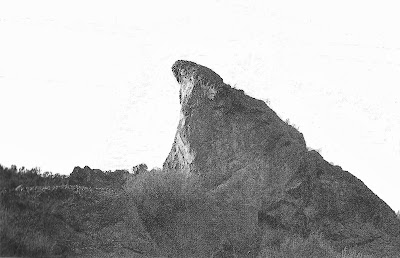Saturday, November 23, 2013
A LOST BUT UNIQUE REPORTED ROCK ART SITE - COYOTE’S PENIS:
Coyote's Penis, Stein River Valley, British Columbia.
York, 1993, They Write Their Dreams on the Rocks
Forever, fig. 13, p. 8.
On occasion rock art would be located in a place that lends
meaning or power to the imagery because of features of the local topography.
Such a place is found in the Stein River Valley of British Columbia, Canada, at a feature known as Coyote’s Penis.
“Indians also
frequently painted pictures on rocks which were thought to be metamorphosis
beings (originally human or semi-human, semi-animal, or semi-God-like
character) concerning which, there were stories in their ancient mythological
tales or traditions. These rocks are generally boulders corresponding roughly
to human and animal forms or to parts of the body, etc., or to rocks worn into
peculiar or fantastic forms of various kinds, suiting in some way the story
that is told of them. By painting on them power in some degree, it was thought,
might be obtained from them or their spirits. . . (Teit 1918:3).” (York 1993:8)
“One of these sites is
found at Spence’s Bridge in the vicinity of Spaeks ha snikiap (Coyote’s Penis)
were the genitals of Coyote and his wife, as well as her woven cooking basket,
were turned to three rock formations by Xwekt’xwektl. Xwekt’xwektl had tried to transform them
totally to stone but due to the countervailing shamanic power of Coyote, the
transformer was able to succeed only with the Coyote’s penis, his wife’s vulva
and the basket kettle from which they had been picknicking (Teit 1898:44, n.
132; 1900:337).” (York 1993:8-9)
In this case the local First Nation’s population remembers
that there is a rock art panel near Coyote’s Penis but it has not been located
in contemporary searches. Perhaps some damage has destroyed it, or perhaps
vegetation is currently concealing the pictographs. One has to hope that it will be rediscovered and recorded as rock art from such a location carries possibly evocative meaning and content. At worst we can hope that it illustrates the myth recorded above, and thus would give us an opportunity for comparative analysis. In any case it does carry a very large curiosity factor.
REFERENCES:
Teit, J. A.
1898 Traditions
of the Thompson River Indians of British Columbia, American Folklore
Society, Houghton Mifflin, New York.
York, Annie, Richard Daly, and Chris Arnett
1993 They
Write Their Dream on the Rock Forever: Rock Writings of the Stein River Valley
of British Columbia, Talonbooks, Vancouver, British Columbia.
Labels:
British Columbia,
Canada,
Coyote,
Coyote's Penis,
pictographs,
rock art,
Stein River
Subscribe to:
Post Comments (Atom)





No comments:
Post a Comment